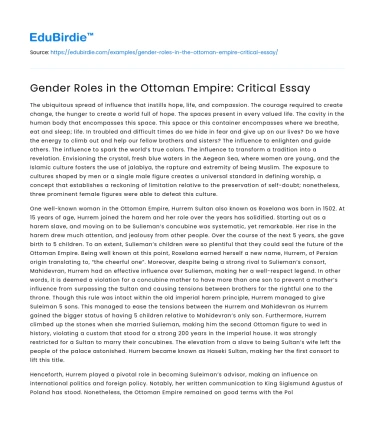The ubiquitous spread of influence that instills hope, life, and compassion. The courage required to create change, the hunger to create a world full of hope. The spaces present in every valued life. The cavity in the human body that encompasses this space. This space or this container encompasses where we breathe, eat and sleep; life. In troubled and difficult times do we hide in fear and give up on our lives? Do we have the energy to climb out and help our fellow brothers and sisters? The influence to enlighten and guide others. The influence to spark the world’s true colors. The influence to transform a tradition into a revelation. Envisioning the crystal, fresh blue waters in the Aegean Sea, where women are young, and the Islamic culture fosters the use of jalabiya, the rapture and extremity of being Muslim. The exposure to cultures shaped by men or a single male figure creates a universal standard in defining worship, a concept that establishes a reckoning of limitation relative to the preservation of self-doubt; nonetheless, three prominent female figures were able to defeat this culture.
One well-known woman in the Ottoman Empire, Hurrem Sultan also known as Roxelana was born in 1502. At 15 years of age, Hurrem joined the harem and her role over the years has solidified. Starting out as a harem slave, and moving on to be Sulieman’s concubine was systematic, yet remarkable. Her rise in the harem drew much attention, and jealousy from other people. Over the course of the next 5 years, she gave birth to 5 children. To an extent, Sulieman’s children were so plentiful that they could seal the future of the Ottoman Empire. Being well known at this point, Roxelana earned herself a new name, Hurrem, of Persian origin translating to, “the cheerful one”. Moreover, despite being a strong rival to Sulieman’s consort, Mahidevran, Hurrem had an effective influence over Sulieman, making her a well-respect legend. In other words, it is deemed a violation for a concubine mother to have more than one son to prevent a mother’s influence from surpassing the Sultan and causing tensions between brothers for the rightful one to the throne. Though this rule was intact within the old imperial harem principle, Hurrem managed to give Suleiman 5 sons. This managed to ease the tensions between the Hurrem and Mahidevran as Hurrem gained the bigger status of having 5 children relative to Mahidevran’s only son. Furthermore, Hurrem climbed up the stones when she married Sulieman, making him the second Ottoman figure to wed in history, violating a custom that stood for a strong 200 years in the imperial house. It was strongly restricted for a Sultan to marry their concubines. The elevation from a slave to being Sultan’s wife left the people of the palace astonished. Hurrem became known as Haseki Sultan, making her the first consort to lift this title.
Henceforth, Hurrem played a pivotal role in becoming Suleiman’s advisor, making an influence on international politics and foreign policy. Notably, her written communication to King Sigismund Agustus of Poland has stood. Nonetheless, the Ottoman Empire remained on good terms with the Polish state during her lifetime. Meanwhile, Hurrem acted in other works such as public buildings that stretched from Mecca to Jerusalem. She helped build a mosque, along with two schools that were tailored to Quranic studies, a fountain, and a women’s hospital. The hospital is the first complex built in Istanbul under Mimar Sinan as an architect. Sitting as the third largest building in the capital proves Hurrem’s exceptional status.
Likewise, Fatima Mernissi, born and raised in Fez, Morocco experienced a harem similar to Hurrem. Mernissi, a Moroccan writer and sociologist was born on September 27, 1940. Fatima provides a view of her experiences growing up in a Moroccan household harem in the course of the 1940s and early 1950s via her book, Dreams of Trespass. In a similar fashion, she describes how a doorman was always present to ensure that women weren’t leaving the harem without the husband’s permission like that of Hurrem. The book offers a glimpse into the family’s cultures, secrets, fun activities, and most importantly the experience of living in a household with a father that displays more than one life. Despite having a strong feminist point of view throughout the novel, Mernissi speaks zealously of the times she spent with her extended family and her childhood. While Mernissi expresses her thoughts on the lifestyle's flaws, she still honors her roots. Hence, Habiba, Fatima’s aunt says, “When you happen to be trapped powerless behind walls, stuck in a dead-end harem, you dream of escape. And magic flourishes when you spell out that dream and make the frontiers vanish. Dreams can change your life, and eventually the world. Liberation starts with images dancing in your little head, and you can translate those images into words. And words cost nothing (pg. 113). A pure form of inspiration and sensuality, this powerful statement by Aunt Habiba can pause the whole world and be listened to through the clouds. A vibrant yet energetic form of describing the concept of freedom. In a woman's perspective does freedom pertain to physical barriers? Is freedom a self-construct thing and if so, how does one formulate it? Is freedom a form of magic? Magic serves as a ubiquitous basis throughout the novel through its form of informative, yet entertaining style. A form that assembles understanding and appreciation for the lives of women in the Arabic world. Though Hurrem placed a bigger emphasis on evolving through the ranks of the harem, Fatima Mernissi was more committed to social change. A more organic intellectual that was compatible with the rhythmic flow of society, harem. An Islamic feminist, Mernissi instilled a strong basis for women’s rights through her experiences and writing. She never tolerated immobility or frailty, as her writing further proves her strong confidence in communicating women’s ability and right to be free.






 Stuck on your essay?
Stuck on your essay?

